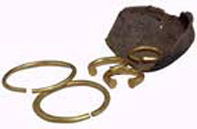
During the Early Bronze Age not many people possessed the knowledge, skills and resources to create bronze objects. Bronze production was rare and was used primarily for highly prized items.
By the Late Bronze Age production was more widespread and commonly used for weapons and tools.
What is Bronze?
Bronze is produced by mixing copper with a small amount of tin or arsenic (pure Bronze is 10 per cent tin and 90 per copper). The addition of tin to copper formed a material that was less brittle, and stronger - making it easier to work.
On the present day site of Blue Bridge, overlooking Bancroft Park stood an imposing round house. This building was part of a Late Bronze Age/Early Iron Age farmstead and was home to the first permanent settlers of Milton Keynes. The size of the building is enormous, and would easily house a large extended family or a small community. It is the largest Bronze Age Round House yet to have been found in Britain and is likely to have been associated with a wealthy or powerful group of people.

Reconstruction of the Blue Bridge Round House
Explore the above picture and click on the wall to find out more!


Explore picture above to find out more!
Farming
Cattle, sheep, goats and pigs were reared at Blue Bridge. Deer bones were also found - indicating that hunting was still important. There is also evidence for wheat cultivation. The surrounding landscape was probably wooded or covered in scrub and bushes rather than open pastures suitable for grazing stock - suggesting that farming was not intensive.
Technology
Practically every thing required in everyday life was made on the farmstead. Clothes were made from cloth that had been woven on hand made looms. Even metal tools were produced from pouring molten metal into clay moulds.
Entertainment and Fashion
Life was a full time job although there was still time to entertain or celebrate within the farmstead on occasions. Some of the pottery that was found on the site was rare and probably imported over long distances. It was certainly not the sort for everyday use, more like wedding set best. It is believed they were manufactured to resemble high status metal vessels associated with the elite in Europe. Seemingly our early ancestors were just as concerned with fashion and keeping up with the Jones' as we are today with our fake furs and plastic imitating leather.
During the late Bronze Age there is more evidence of elite activity in other parts of Milton Keynes. A bronze sword was thrown into the River Ouse possibly as an act of commemoration or as a religious offering. Deposits of gold were also hidden in the ground including a rare gold bracelet and a hoard of jewellery that is one of the biggest concentrations of Bronze Age gold known from Britain. The jewellery hoard included two torcs (necklaces) and three bracelets. To see the replica torcs and learn more about the Bronze Age visit Milton Keynes Museum or view their website.

| Stone Age | Bronze Age | Iron Age | Roman Britain |